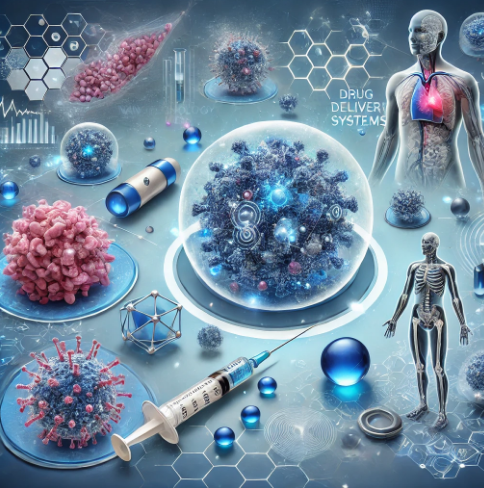Introduction
Nanotechnology has emerged as a revolutionary tool in the pharmaceutical industry, particularly in drug delivery systems. This cutting-edge technology enables more precise delivery of therapeutic agents, enhancing their effectiveness while minimizing side effects. By utilizing nanoparticles, drugs can be targeted directly to diseased cells, improving bioavailability and offering significant advantages over traditional methods. In this article, we explore how nanotechnology is transforming drug delivery, its current applications, challenges, and the future potential in personalized medicine and other medical fields.
Understanding Nanotechnology in Drug Delivery
Nanotechnology involves the manipulation of matter on an atomic and molecular scale, typically between 1 and 100 nanometers. In drug delivery, nanoparticles are engineered to carry therapeutic agents, such as drugs, genes, or proteins, to specific sites in the body. These nanoparticles can be designed to release their payload in a controlled manner, often responding to specific biological signals, such as changes in pH, temperature, or enzyme activity.
The most commonly used nanoparticles include:
- Liposomes: Spherical vesicles made from lipid bilayers, often used to encapsulate drugs.
- Polymeric Nanoparticles: Biodegradable particles that can carry both hydrophilic and hydrophobic drugs.
- Dendrimers: Highly branched polymers that allow for precise drug delivery at a molecular level.
Mechanism of Nanoparticles in Drug Delivery
Nanoparticles improve drug delivery through several key mechanisms:
- Enhanced Permeation and Retention (EPR) Effect: Tumors and inflamed tissues often have leaky blood vessels, which allow nanoparticles to accumulate more easily in these areas, providing targeted drug delivery.
- Surface Modification: Nanoparticles can be coated with specific ligands that bind to receptors on the surface of diseased cells, ensuring that the therapeutic agents are delivered precisely where they are needed.
- Controlled Release: Many nanoparticles are designed to release their drug load in response to certain stimuli, such as the acidic environment of a tumor, ensuring that the drug is only activated in the target area.
Current Applications of Nanotechnology in Drug Delivery
- Cancer Therapy
Nanotechnology has made significant advances in cancer treatment. Traditional chemotherapy drugs often affect both cancerous and healthy cells, leading to severe side effects. Nanoparticles, however, can deliver drugs specifically to cancer cells, reducing toxicity to healthy tissues. One example is Doxil®, a liposomal formulation of the chemotherapy drug doxorubicin, which enhances drug concentration in cancer cells while minimizing damage to healthy cells. - Neurological Disorders
The blood-brain barrier (BBB) is a major obstacle in treating neurological diseases. Nanoparticles can cross this barrier, allowing for more effective treatment of conditions like Alzheimer’s, Parkinson’s, and brain tumors. Researchers are developing nanoparticles that carry neuroprotective agents or therapeutic genes directly to the brain, which could revolutionize the treatment of neurodegenerative diseases. - Gene Therapy
Gene therapy involves modifying or replacing defective genes to treat genetic disorders. Nanoparticles, particularly viral and non-viral vectors, are used to deliver therapeutic genes to the target cells. By incorporating nanotechnology, gene therapy can achieve higher efficiency, better targeting, and lower immune responses. - Infectious Diseases
Nanoparticles are being explored for their potential in combating infectious diseases like tuberculosis and HIV. In some cases, nanoparticles can be used to deliver antibiotics more effectively or to enhance vaccine efficacy by acting as adjuvants, stimulating a stronger immune response.
Challenges and Limitations of Nanotechnology in Drug Delivery
Despite the many advantages of nanotechnology in drug delivery, there are still several challenges to overcome:
- Manufacturing Complexity
Producing nanoparticles with the desired properties for drug delivery is technically challenging. The process often requires precise control over size, shape, and surface characteristics to ensure that the nanoparticles behave as intended in the body. - Safety and Toxicity
Although nanoparticles offer targeted drug delivery, their long-term safety is not fully understood. Some nanoparticles may accumulate in organs, leading to potential toxicity or immune reactions. Thorough preclinical and clinical testing is necessary to ensure the safety of nanomedicines. - Regulatory Hurdles
Regulatory approval for nanomedicines can be more complicated than for traditional drugs due to their novel properties. There are concerns about their environmental impact, manufacturing standards, and long-term effects on human health, which regulatory bodies like the FDA and EMA must carefully evaluate.
Future Directions and Potential
The future of nanotechnology in drug delivery is promising, with several exciting avenues for exploration:
- Personalized Nanomedicine
Personalized medicine, which tailors treatments to individual patients based on their genetic makeup, could be enhanced by nanotechnology. Researchers are developing nanoparticles that can be customized for each patient, improving drug efficacy and reducing side effects. - Smart Drug Delivery Systems
Future drug delivery systems may become even more sophisticated, with nanoparticles capable of responding to multiple biological cues. These “smart” nanoparticles could release drugs in response to complex conditions, such as a combination of pH changes, enzyme activity, and temperature variations, ensuring more precise control over drug release. - Nanoparticles in Regenerative Medicine
Nanotechnology could play a crucial role in tissue regeneration and wound healing. Nanoparticles that deliver growth factors, stem cells, or other regenerative agents could help repair damaged tissues and accelerate the healing process.
Conclusion
Nanotechnology is transforming the pharmaceutical landscape, particularly in drug delivery systems. By enabling more precise targeting, controlled drug release, and improved bioavailability, nanotechnology offers numerous advantages over traditional drug delivery methods. However, challenges such as manufacturing complexity, safety concerns, and regulatory hurdles must be addressed before the full potential of this technology can be realized. As research continues, nanotechnology is poised to become an integral part of personalized medicine, cancer therapy, and treatments for neurological and infectious diseases, shaping the future of healthcare.
References
- Wagner, V., Dullaart, A., & Bock, A. K. (2006). “The Emerging Nanomedicine Landscape.” Nature Biotechnology, 24(10), 1211-1217.
- Peer, D., Karp, J. M., Hong, S., Farokhzad, O. C., Margalit, R., & Langer, R. (2007). “Nanocarriers as an Emerging Platform for Cancer Therapy.” Nature Nanotechnology, 2(12), 751-760.
- Davis, M. E., Chen, Z. G., & Shin, D. M. (2008). “Nanoparticle Therapeutics: An Emerging Treatment Modality for Cancer.” Nature Reviews Drug Discovery, 7(9), 771-782.
